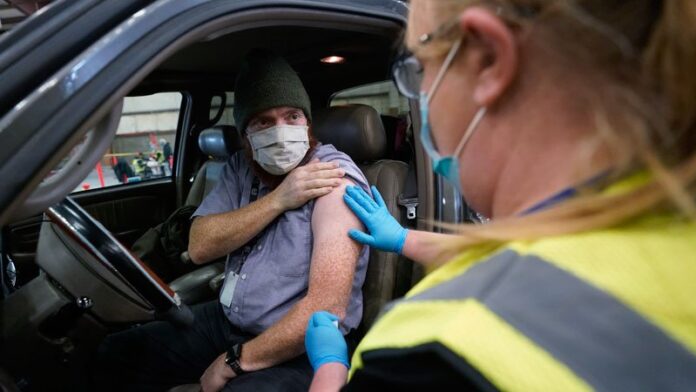[ad_1]
Drive-thru COVID-19 vaccination sites, if set up nationwide on a massive scale, could significantly speed up the number of Americans vaccinated, according to new research that provides a detailed model for how to do it.
Based on the suggested model, 350 million doses could be given in 100 days, says study co-author Sunderesh Heragu, PhD, a professor of industrial engineering and management at Oklahoma State University. That’s enough to cover the U.S. adult population, and then some.
Heragu originally developed the model for the swine flu (H1N1) pandemic in 2009, and it was used to vaccinate more than 19,000 people in 1½ days at a mass vaccination site in Louisville, KY. While drive-thru vaccinations are not new, even in the current pandemic, Heragu’s model comes with specific guidelines to maximize efficiency. President Joe Biden has set a goal of giving 100 million COVID vaccine shots by April 30, his 100th day in office. As of Thursday, 57.5 million of the shots had been given, according to the CDC.
The proposed new model, say its developers, could more than triple that number in 100 days.
The entire U.S. population is 332 million, including 77 million children, who aren’t yet eligible to get the vaccine. If only the adult population of 255 million is considered, 57.5 million of whom have already been vaccinated, Heragu says, numerous second doses could also be given during that 100 days at the drive-up mass vaccination sites if the new model is used.
Table of Contents
How the Model Works
The model assumes that 350 mass vaccination sites would be set up across the country and that vaccinations would be given 7 days a week for 8 hours a day. Each location would dispense 10,000 shots a day, for a total of 1 million vaccinations per site over 100 days, or 350 million shots total, Heragu says.
At mass vaccination sites in operation now, he says, the number of shots is much lower than his 10,000 goal. “Typically it is 1,000 to 2,000 a day,” Heragu says.
To reach the 10,000 goal, each site should include:
-
Five tents, with each tent serving two cars at once
-
Four nurses’ stations in each tent, with two nurses per station, for a total of 40 nurses per site (or more, if they reduce shifts to less than 8 hours)
The model plugs in several other scenarios, such as estimating vehicles would travel through the site at 7.5 miles per hour, and drivers would have a wait time of about 25 minutes. The simulated model, based on the Louisville vaccinations, includes time for a consent form to be signed. If a consent form is completed online before the vaccination appointment, that could shave off 2 or 3 minutes, Heragu says, and increase the total number of vaccinations.
It Worked in Louisville
At the Louisville site that used the model in 2009, 19,000 shots were given in just 1½ days, Heragu says. That vaccination program included options for drive-thru and for walk-up. “They had 19,000 doses, and more than 12,000 were done through the drive-thru, and about one-third through the walk-up,” he says.
Drive-thru clinics are able to vaccinate many more people per hour than walk-up clinics, Heragu says. In the Louisville vaccination project, 424 people got vaccinated per hour in the walk-up site and 762 per hour in the drive-thru.
Other Benefits of Drive-Thru Vaccination
In the Louisville vaccination rollout, people preferred the drive-thru option, Heragu says. At some points, he says, ”often we had the walk-up site with no one waiting, and the drive-thru with a 30-minute wait. The attendant would say, ‘You can exit the drive-thru [and go to the walk-up.]’ “
Usually, Heragu says, people chose to wait in the drive-thru. Convenience and habit may explain that preference, he says. “People are used to doing a drive-thru for a bank transaction, for breakfast, even dry cleaning, and more recently for voting.”
Health concerns are another reason many prefer the drive-up option, he suspects. “When people are in their own car, they are not concerned about contracting the virus,” he says.
Children in the car with their parents are often more comfortable staying in the car, and parents of infants would not have the extra task of taking infants in and out of car seats to use walk-up sites, he says.
Perspective
The drive-thru option for vaccination is definitely efficient, says Michael F. Gorman, PhD, a professor of business analytics and operations at the University of Dayton School of Business in Ohio. He is editor of the INFORMS Journal on Applied Analytics, which published the study.
“The numbers you could do with a [drive-thru] facility like that are very high. We’ve got a really efficient way to deliver it, with high capacity and low costs.”
The unknown, of course, he says, is how reliable the vaccine supply is. He agrees that all the doses estimated in the model ”could be given in 100 days if there are enough vaccines out there, [but] only if there are enough vaccines.”
[ad_2]
Source link












